Explore Posts
No One is Illegal: How do artists address migration and humanize immigration?
Taught by: Mayumi Tan & Anne Marie Busche, María Belén Molina & Stephanie Wan

In this class, students engaged with the complex and urgent issues surrounding immigration in today’s world. As millions are forced to leave their homes due to war, economic hardship, climate change, and violence, the topic has sparked intense global debates. From the arrival of European colonists in 1592 to the discriminatory policies like the 1882 Chinese Exclusion Act, the U.S. has a long and multifaceted history of immigration, often marked by the displacement of indigenous peoples.
Artists are at the forefront of this conversation, using their work not only to reflect the realities of immigration and the refugee crisis but also to challenge and reshape social and political narratives. In this class, students explored how art can serve as a powerful tool for creating counter-stories that humanize the experiences of immigrants and refugees. Utilizing a diverse range of media and creative strategies, participants learned to harness the transformative power of art to foster empathy, dialogue, and change.

Aging Lines: How do artists explore the transformative power of aging?
Taught by: Becky Maric & Heather Brody

As we age, wrinkles, lines, gray hair, and spots are part of an aging body. In our anti-aging culture, where the cult of youthfulness is celebrated and supported by the cosmetic industry, the natural aging process is not celebrated. Instead, the messages we hear from the media and popular culture are that frailty, loneliness, decay, and mortality define old age. Contemporary artists are exploring the ways aging in our culture is a social construction and not a natural biological process that leads to a new stage of opportunity and strength. They explore the wisdom of aging as it is followed by a wealth of experience, power, wisdom, and often a triumph over social conventions. In this class, students explored how aging is constructed and how it has changed over time in our society through the use of varied mediums and artistic methods that included 2D and 3D materials, as well as interviews and other collaborative forms of creative inquiry.
The following is the curriculum map students followed throughout the course:

From Me to We: How do artists connect the self and society?
Taught by: Jovanny Leon and Melissa Quizhpe

Identity is a complicated combination of how we know and express ourselves as individuals and how we are shaped by and perceived through positions including race and ethnicity, gender, economic class, age, physical ability, and many other categories. Artists have always presented themselves in their work – sometimes directly in self-portraits and sometimes indirectly by including autobiographical elements and experiences. These works often critique the systems that stereotype, marginalize, or categorize people in harmful ways. In this class, students investigated the complexity of identity and the possibilities for connecting the self to the community in transformative ways through multimedia art activities that included performance and public work.

The following is the curriculum map students followed throughout the course:

Inviting Risk: Building school community by centering the social and political realities of NYC students
ItAG Participants: Jovanny Leon, María Molina, Annie Yoo
The purpose of our itAG “Inviting Risk: Building School Community by Centering the Social and Political realities of New York City Students” is to raise awareness of the social and political realities of young marginalized people enrolled in NYC DOE school communities in the contemporary world. Implementing a multicultural/anti-racist curriculum will allow students to build upon their identities and clarity of their roots with the result of preparing students for modern society. We believe that there must be a structural shift in how schools build community and how they treat and include incoming immigrant students. We name the art classroom as sacred; a space where students of marginalized identities can share stories and experiences and disrupt the “fear of not knowing”. We acknowledge the art classroom as having a vital role in modifying curricular approaches and strategies to be inclusive of students’ cultural backgrounds and needs (i.e.: linguistically, academically, etc). We are a group of future art teachers who are immigrants/or belong to immigrant families residing in NYC learning to center the experiences and lives of our students in the classroom.
“Inviting Risk” in this project is defined as an invitation that is fostered in the classroom to create a space where authentic learning is occurring where the fear of “messing up” for both the students and the teacher is slowly becoming diminished. Both students and teachers are “taking risk” in learning with one another and learning from each other when embracing home life and student experiences.
In our itAG, we use photovoice as one of the many strategies to uplift students who are both new and accustomed to NYC DOE school communities. By using photovoice, we are using it as a tool for social change. With the responses of our students, in addition to their photography, we are hoping to prove a relationship between home and school and the value of inviting “Risk”. As a group, we want to emphasize the importance, now more than ever, of incorporating our student’s lives and experiences into the classroom and the school culture.
We created a website to demonstrate to future teachers, current teachers, and admin what students are saying and to create a toolkit to enact change within the classroom, and the school community at large! This website and toolkit includes a description of our itAG, about us, what NYC DOE community members can do, Photovoice resources, a bibliography, and our process.

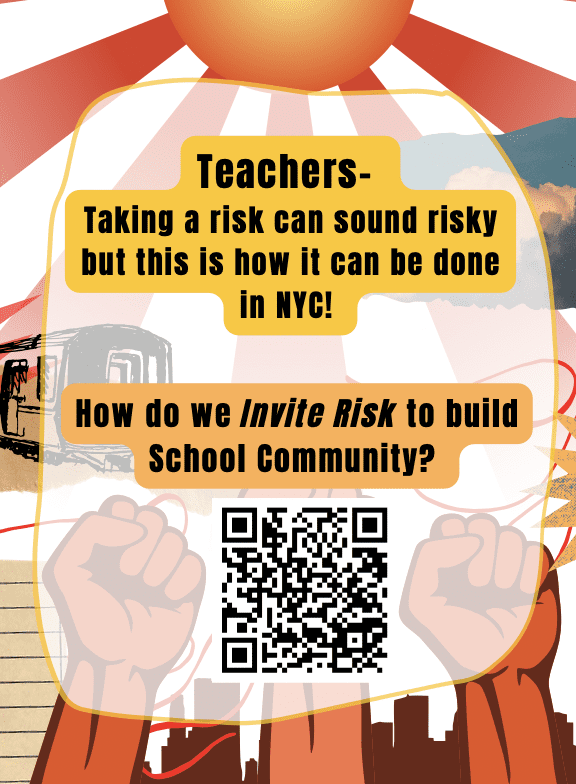
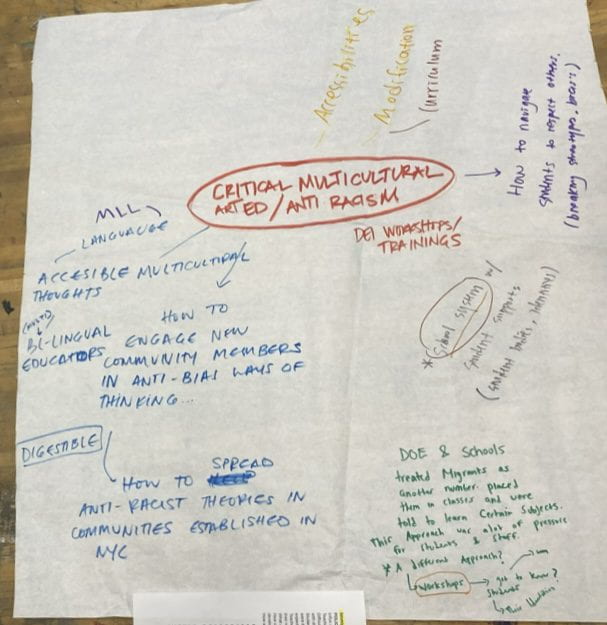

AI: An Interactive Zine for the AI Curious
ItAG Participants: Genevieve Felsenstein, Daniel Martinez, Ros Sterling Winner
We are a trio of graduate students at New York University who are interested in Artificial Intelligence and the impact of AI generated art on the praxis of art education. We created a zine to serve two functions: to introduce the reader to a few AI art projects that can be experienced in tandem with traditional pen and paper art games, and to provide research feedback for us as we consider the bigger picture of AI’s impact on art teachers and their students.

Our project aims to provide teachers and students with a better understanding of AI, and how AI generated art can be implemented in the classroom. AI is developing at an exponential rate, and laws and regulations are always steps behind. Our goal is to create an opportunity for art educators to understand how to respectfully and properly utilize AI within the classroom. As art educators, we hope to lessen the fear and wariness other art educators might feel regarding AI art. Our project explores both the handmade and AI in a way that shows how they can not only coexist, but enhance one another.




Class Size Policy and Practices: A Public Performance
ItAG Participants: Rebecca Maric, Melissa Quizhpe, Stephanie Wan
Our inquiry topic centered on the effects of class size policies in New York City public schools, driven by our shared identities as former students and student teachers within the NYC Department of Education. We each chose this topic because of its negative impact on students in the educational system. Our research process involved brainstorming sessions, researching academic literature, and examining artistic strategies and tactics. This led us to develop an action research project near Astor Place subway station, where we aimed to engage the public in dialogue about class size experiences. Our artistic action involved interactive questions to people passing by. By utilizing visual aids, such as chalk and posters, we drew attention to the issue and had meaningful conversations with individuals who are either current students, former students, partners, and teachers. As future art educators we hope that this project will serve us and many others as a starting point to change class size policy. We encourage others to join us in advocating for students and as we raise more awareness we will listen to the ones most affected.








Student Mental Wellness: The Heartfelt Teaching Project
ItAG Participants: Heather Brody, Emily Nodell, Skylar Spitaleri

Mental wellness has a significant impact on both academic achievement and the general learning environment in schools. More attention has been drawn to the topic of mental health in recent years due to the extreme need for additional support in educational settings. Mental health initiatives are gaining traction as educational institutions prioritize the emotional and psychological needs of their students. Students need a space to process their experiences, reflect on the lasting effects of the pandemic, and look deeper into the influence of social media. Social-emotional learning through art is a gateway for students to understand themselves and the world around them and process the traumas that still have a hold on them. Not only are they able to reflect on their own mental health through art, but they can share their feelings with others who may have had similar experiences. Art serves as an outlet to give students a creative way to express their emotions, reflect, discover themselves, and connect with others. This ItAG invites you to inquire how art can be utilized by students as an effective outlet to help themselves as individuals but also shed light on the growing need for mental health awareness for all.
As individuals, we each have our own experience with the need for mental health support in school settings. This comes from our school experience and the lack of attention and transparency when it comes to topics of mental health. This drew us to inquire about how things might have changed, or not changed since we were in high school.
One creative tactic that inspired our work is developing a sense of “communal meaning.” From the beginning of this research project our intention was to diminish the stigma surrounding mental health and show students and teachers that they are not alone on this journey. We looked at the Subway Therapy project and it’s use of post-its as inspiration to gather information from students using Google Jamboard so they could share how they feel anonymously for others to see and relate. For our final action, we created a website: The Heartfelt Teaching Project to share information and resources with other art teachers and build a sense of community in navigating student’s well-being in the classroom. This is a topic all teachers face, and providing resources for art teachers can make a great impact by showing students that they can use art as an emotional outlet.

One goal we have for our action is to reach as many art teachers as possible. We want the resources we gathered and lessons we created to help teachers who are unsure how to help students with mental wellness, and in turn, help students feel more comfortable in the classroom. We also hope that this action will inspire teachers to take mental wellness into account in the classroom more often by doing check-ins and offering activities to help them de-stress during difficult times. Finally, we hope to build a community by sharing this with others through online platforms such as Facebook and share information and ideas with other art teachers. So far our website has received all positive feedback from different Facebook groups in which we shared it.

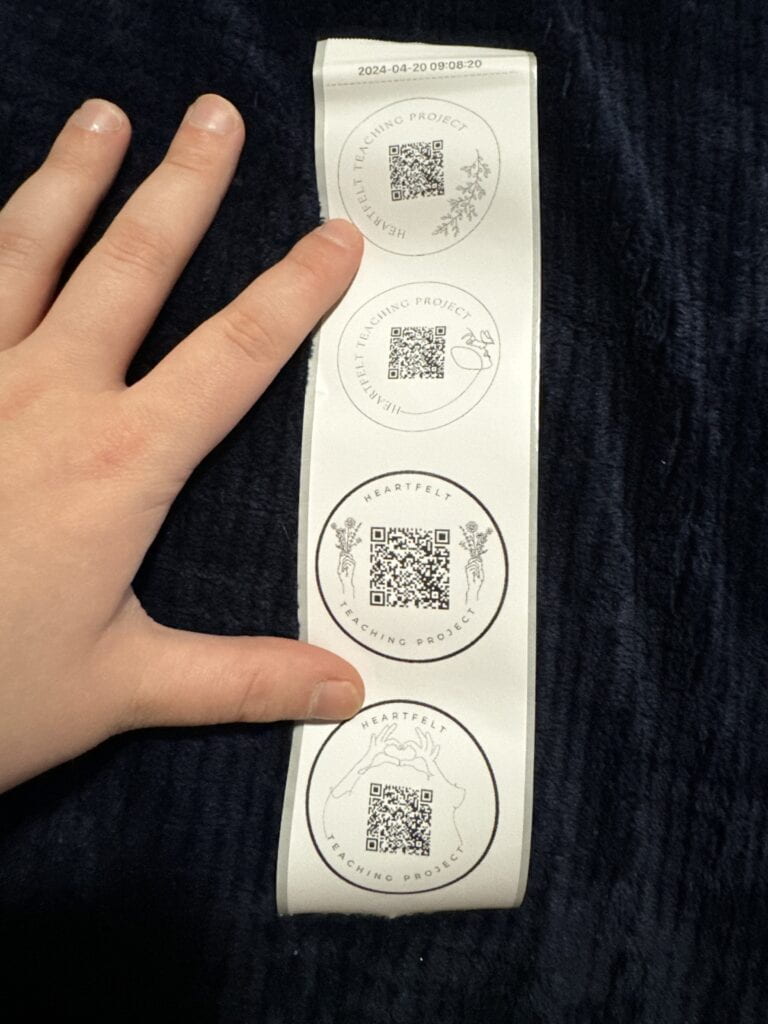
Research and Final Projects 2024
In Spring 2024 we were all feeling the anxieties and conflicts that were headlining news feeds in the US and globally: Hamas’ attack in Israel, Israel’s war in Palestine, Republican and Democratic accusations and fighting, a former president on trial and found guilty of 34 felony counts, immigrants seeking sanctuary, and the realities of climate change and extreme weather. Inside our classroom spaces we were grappling with these larger conversations, while also focusing on the realities and possibilities for public schools, for art curricula, and for meaningfully engaging students. Our Research and Final Projects class began by asking what topics and concerns were top of mind for emerging teachers. We identified issues such as restorative justice and art education, anti-racism efforts and DEI training in schools, art education in the anthropocene and AI and technology.
 Eventually students formed groups to explore 4 topics using a collective inquiry to action methodology:
Eventually students formed groups to explore 4 topics using a collective inquiry to action methodology:
Class Size Policy (Rebecca Maric, Melissa Quizhpe, Stephanie Wan)
AI in the Art Classroom (Genevieve Felsenstein, Daniel Martinez, Ros Sterling Winner)
Critical Multiculturalism and Multilingual Learners (Jovanny Leon, María Molina, Annie Yoo)
Student Mental Health and Wellness (Heather Broday, Emily Nodell, Skylar Spitaleri)
We explored creative research methods including visual mapping, interviewing and surveys, photovoice and radical listening to learn about these topics and implement them in collaboration with students and teachers in New York City. In addition to doing research specific to each topic, we looked at the work of socially and civically engaged artists to help us think about how we take our knowledge and learnings and engage other people in order to enact necessary change in the world. In the end, each group created a proposal for an ‘Action’ to share their learning and transform their knowledge into impact. Students staged a public performance to help advocate for greater awareness and participation in reducing class sizes in New York City, they produced an interactive handmade Zine to help teachers build their familiarity with and ability to navigate the critical aspects of AI in a visual art curriculum, they created an online mental wellness resources for NYC high school students and a curriculum and toolkit using photovoice to support new students arriving in NYC from other countries. Each group presented their work, their research process, and their final resources with each other offering them as tools to support their future teaching and share with friends and colleagues.
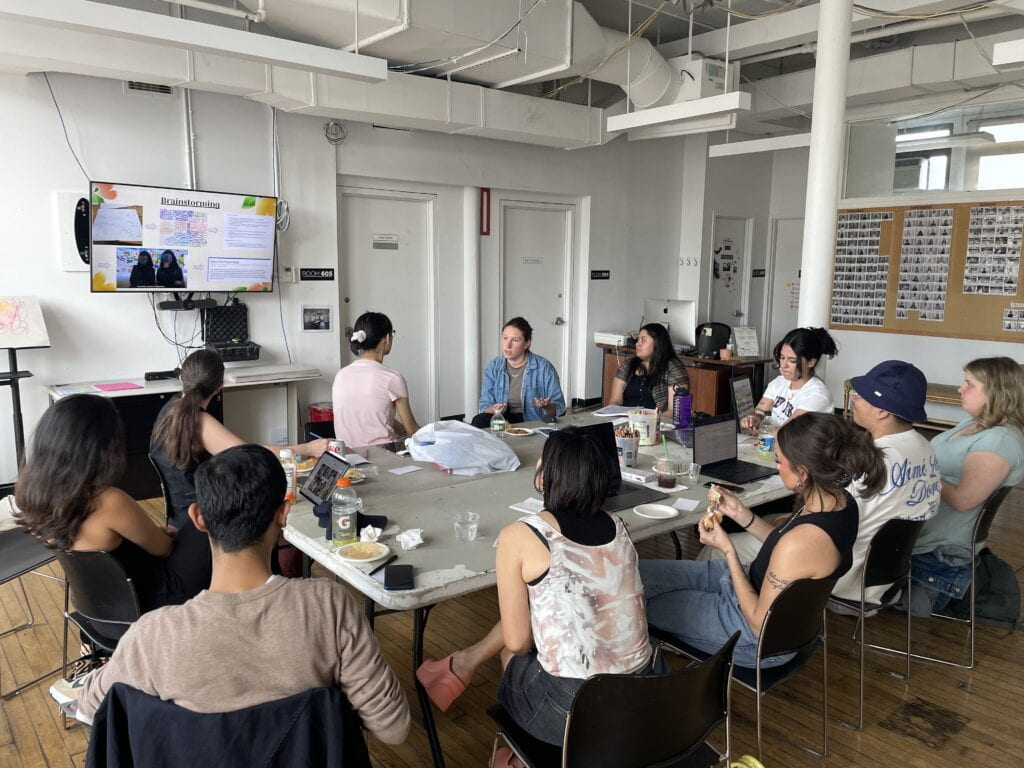
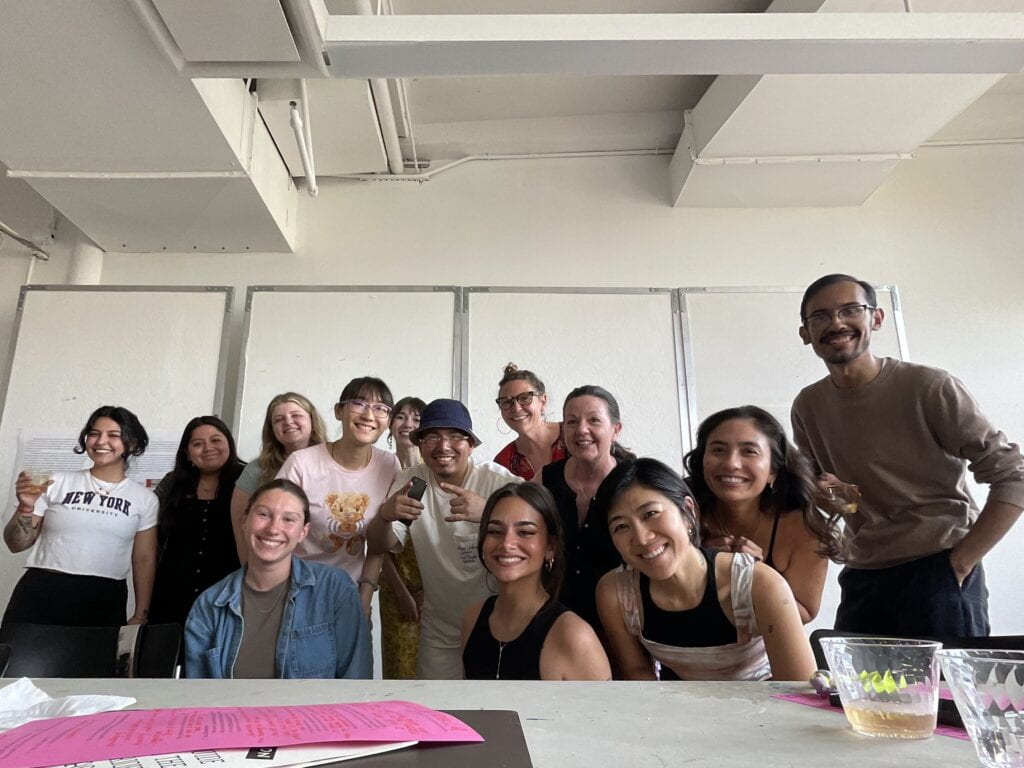
Art Education Advocacy
Research and Final Project Spring 2023 ItAG: Art Education Advocacy
ItAG members: Kenzie Cuvelier and Annie Busche
Our research focused on the topic of Art Education Advocacy. We wanted students, teachers, faculty, and those who are no longer in school to understand the importance and benefits of visual art education. All over the United States, schools take art programs for granted, implementing budget cuts and regarding the subject as a ‘special’ or extra. Why is it always art that is the first to go? We decided to take action and do some research about why schools were not focused on the arts. We gathered information from students, teachers and administrators currently in schools and those who were no longer in school.
We wanted to gather information and data about New York City schools specifically and used interviews and a survey to collect information. We found out that there was minimal knowledge about why the arts are an important subject in relation to other subjects. We also found studies that show how art education helps students learn the skills of patience, problem solving, critical thinking, basic motor skills, decision making, inventiveness, and risk taking – in addition to the foundation concepts of visual literacy. Our mission was to help provide a clear understanding of these benefits that art education provides to students. After discussing many forms of sharing the benefits, stickers were created to grab attention, raise awareness, and put this information in the public eye. New York City is known for sticker bombing and tagging and students, teachers, faculty, and non school attendees often put stickers on laptops and water bottles. We also decided to create a manifesto to go along with our stickers. The manifesto was inspired by our research and is another way of presenting and distributing our data.
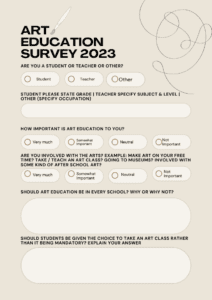
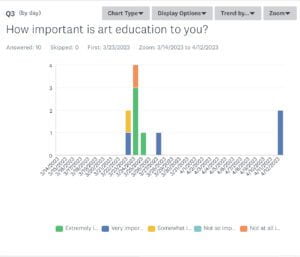
Along with the data we’ve collected, we chose six core values that describe what we believe should be recognized:
Art/Design is Storytelling
Comfort with Ambiguity
Transdisciplinary Researchers
Idea Generators
Mind/Body/Soul
Critical Multicultural Art Education
Our manifesto represents a change in language around how art education is currently valued in schools and points to a potential shift in how we might conceptualize arts’ purpose in education. We commit to upholding these values as we further our own practices as educators. We designed our materials to serve as reminders of our beliefs and encourage the use of our manifesto to be displayed as a poster or public sign. We created a PDF that was sent out to teachers, administrations, and students via email to be downloaded, printed, and shared as a way to inspire conversation and expand knowledge about the importance of art education. We will continue to further our research and update our posters / social media platforms as necessary.
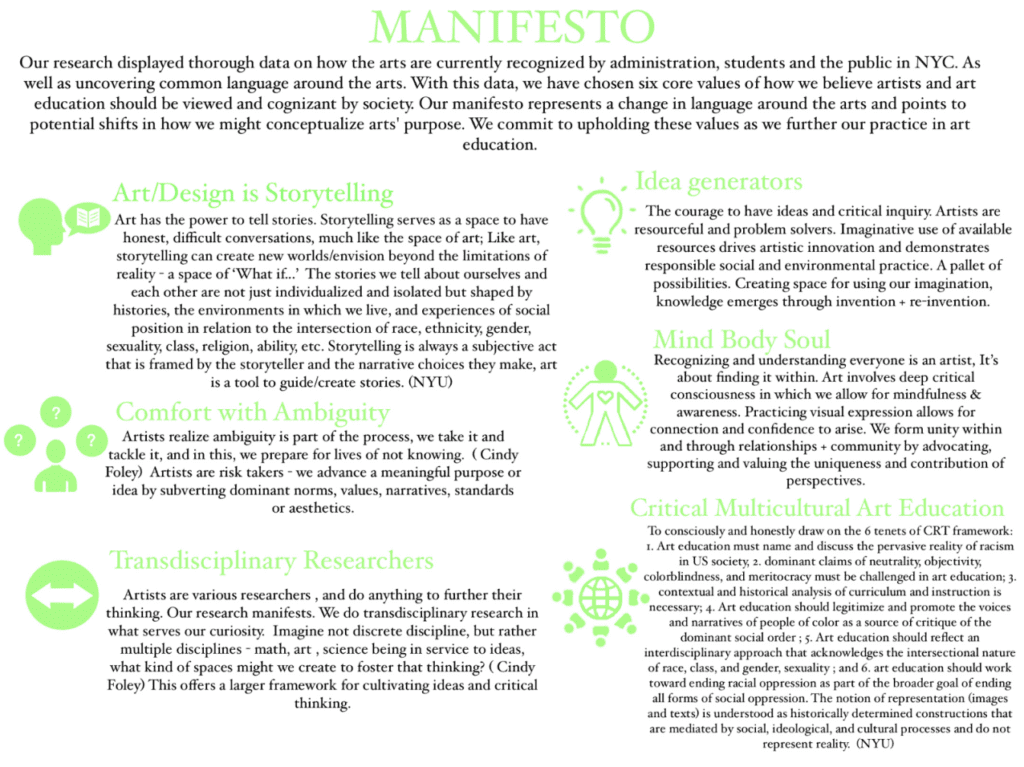
Download a PDF of the Art Advocacy Manifesto:










